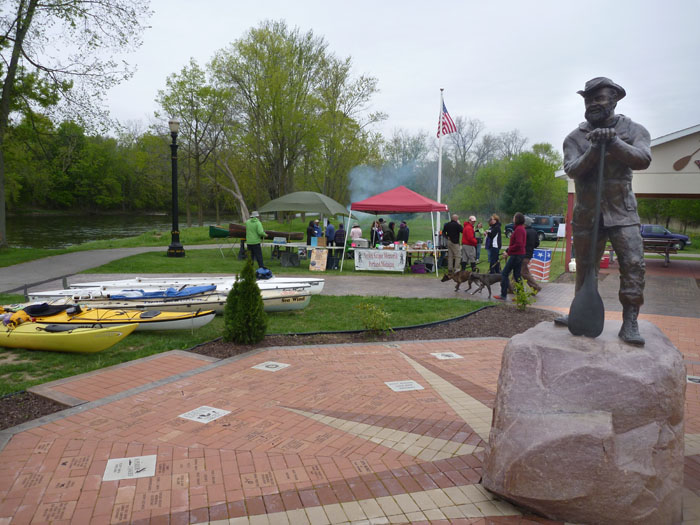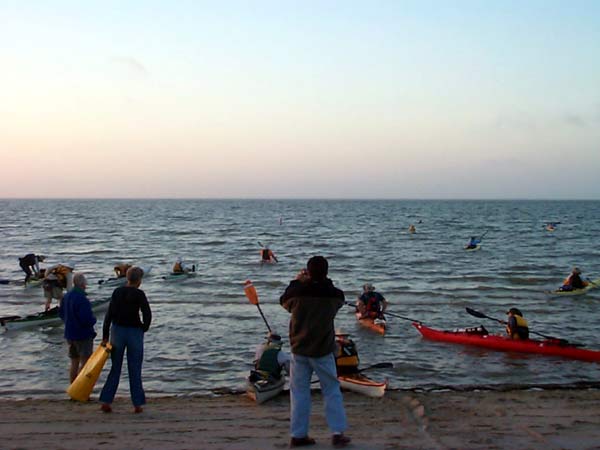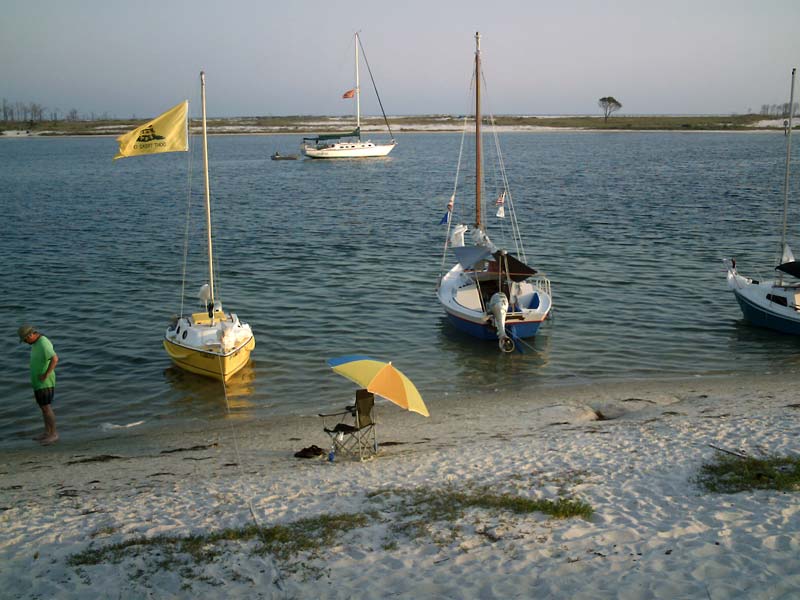More Photos Below!Gallery
OK, Tim Feldkamp and I paddled the full 50-mile Hugh Heward Canoe Challenge last Saturday. I was still tired on Sunday and creaky on Monday. Whew!
We had a dandy time. It took us 10 hours. The river was pretty slow and clear. But nice’n’clear in many places. Our onboard GPS said we were going 5.5-7mph most of the day.
I really like sweeping around all the big bends and seeing the far forest ridges beyond the acreage of the lowland oxbow interiors. So many nice forest ridges. So many nice old riverside homes. Some goofy new ones, too.
Several different mayfly hatches came off the water during the day, making a kind of nice company for us, sailing along the water with their little wings drying, with all sorts of minnows constantly gulping them down.
I’ve reported here many times about the historic background of this event so I won’t repeat that now. (Just search for it. It’s really cool, if you don’t know it already.)
It was supposed to rain and snow and so only half the usual people showed up, even though this is already a tough-paddlers only sort of event. Scared off even the toughies, I guess. It stayed cool and mild the whole day so we lucked out. Even if bad weather hits it’s a Big Day and they’ve never yet had it bad ALL day.
I think the best way to go, if you’re doing the whole deal, is to camp out in the park the night before and start at 6am or whatever with all the tourers. The racers start at 9am and you know who you are.
It was a bit of a chilly morning at 40degF. We started at 7:45 despite waking up at 5am at our houses and getting rolling pretty promptly. Even if you live close to this event it’s hard to get up at a reasonable hour then do the shuttle and start with the others. It didn’t used to start as early but that’s what they like now so there ya go. It’s really a campout plus day-paddle now.
There are Half Hugh and Quarter options, though, for normal non-crazies. But it’s fun to paddle through Lansing and get the whole social transition feel as the river gets rural and then quite wild before ending up in the quaint little town of Portland.
So we used Tim’s carbon Crozier race boat and tiny, fancy featherweight new-type paddles. They make my old carbon paddle seem like a club.
Tim has been working with me a bit on technique so that was cool. We slowed our tempo down for this Big Day, though.
We traded bow and stern at one point. When Tim went up front I tried to copy him and we got an interesting timing going for awhile that seemed to work good and our speed went up a fair bit, from 6.5 to 7. That’s a sizable jump in canoeing, I think. I suppose it’s because the bowman is the motor and Tim is a real paddler — he’s done 10 Hughs and several AuSable Marathons — up front he didn’t have to worry about navigation. Except I kept wanting him to call the huts up front anyway. When he was in back we went straight, when I was we went snaky.
It was fun getting into a good form hone sometimes. I don’t know what Tim thought but sometimes I felt pretty good. It was neat to feel centered in the boat, rotating and working around an axis going up my torso instead of having a “working off to one side” feeling.
We brought a few sandwiches and liters of drinks plus dry socks in case.
I took photos of nifty houses that we passed. I’m really bummed because I neglected to take 4 photos that I should’ve, 3 being “must takes” that I should’ve known better about. I’ll post a few that I did take, but here are the ones I missed:
*We stopped at Jim Woodruff’s Landing near the halfway point and paid a visit to Jim and his helpful daughter. Jim is 90 years old now and is the guy who started this whole event with his historic inquests. He had canoe awards and memorabilia laid out in his kitchen overlooking the river. And I didn’t take a photo of the old goat and his beautiful daughter!
*Jim also had a gorgeous old Krag 6.5×55 rifle leaning in a corner. His last gun, he said. It’s a classic that I haven’t thought about in years, pre-WW1. It was very popular among early budget-minded outdoorsmen and live-off-the-land types of the post-cowboy, early-modern era. What’s more, Jim had done a lot of fancy carving on the stock — regular checkering and then some — elaborate floral curves. I love self-modified guns. His was totally pro. Just a beauty. What’s even more (?), it had a full Mannlicher stock out to the end of the barrel. Fine walnut. A rare beauty. Shoulda taken a snap. Not that it’s canoeing related but that’s OYB for ya.
*I never took any pics, really, of folks paddling! We passed quite a few different folks on the river along the way. I could’ve taken a nice variety of snaps. Instead I was slowing us up to take pics of silly HOUSES! Ugh! My bro — who is a pro photographer — wouldn’t’ve made such a lame mistake. But I do find it VERY hard to be both doing something and observing it via camera! In fact, I’ve heard of more than one big adventure gone bad or highly stressed by the attempt to add photography to the mix. I understand that well! Anyway, I’ll just tell you instead that it was fun to pass Charlie Parmalee in his Kruger boat. Another guy was out in a Bell Rob Roy 15 with a beautiful paddle that we could see flashing from 100 yards away — wood with lovely horizontal laminates on the blade. He also had a doublepaddle stashed that he used some — SMART! I think it’s a great idea to change things up during a Big Day like this. We saw quite a few neat Kruger boat paddlers. One guy did a neat Seal Launch in front of us at Jim’s Landing. I took a video of it, so I got that. I’ll upload it to YouTube I spose.
*There was one superparty Landing near Grand Ledge. I like seeing people’s riverside party set-ups. We did pass a group that was rolling up their sleeping bags near a firepit so they must’ve had some fun. But I missed taking a pic of the best one: a Landing full of outdoor toys of all sorts, a rope swing — and a ratty old mannequin with hat and fishing pole. I remember seeing it before. Plus there were fishing forks stuck in the banks — always a good sign. What’s lame, though, is to see fancy houses backing up to the river with no sign that the people have actually walked on the banks or done anything in the water.
Aside from not taking the right photos, and not really paddling with other folks, we had a nice time chatting our way down the river. We had particular fun discussing new canoe events like obstacle courses with portages. Tim puts on the annual Ann Arbor canoe races. He could add a new event if he had another volunteer who’d help. (You?) I’ve been promoting a “boatocross” form of singletrack paddling where you go around obstacles using skill, but I was thinking of natural barriers like logjams and narrow, twisty creeks. Tim suggested stringing together foam noodles and buoys around a pond to make something like a slalom course without the vertical drop and whitewater. (Why do the slipperboats get all the attention? We flaterwater folks could have skilz fun, too.) You’d want to portage the boat a few times — like cyclocross racers carrying their bikes. Actually, in world cup flatwater marathon kayaking they always have the most spectators at the portages. Same with Quebec’s big canoe races — they portage through towns with thousands lining the way cheering. So our compact obstacle course would be fun to watch, with, like, 3 portages.
OK, lessons learned: if you want to go all the way, make sure you put in a few long outings beforehand, at least 6-10 hrs paddling in the weeks leading up. My wrist finally started to degrade a half hour from the finish. Whew. I’d only paddled 4 times, with one 2-3 hour jaunt. That’s about half enough. Also, near the finish the boat started to feel like it was stuck in cement and the paddle felt like it was moving through cement — my shoulders and elbows started giving out, too, come to think of it. You gotta toughen up the joints beforehand.
“Use enough boat.” The Grand is big, you could go 24-feet long for a tandem if you liked. Longer glides better. OK, superlong would need to be custom, so just grab some 18.5-footer you can find — they’re more common.
If you’re not a racer, slow that stroke-rate down. I don’t need to tell hardly anyone this, though, I suppose. ONLY ME! We were paddling a bit too briskly for me being outta shape. But Tim has been doing 30-milers even through the winter so he don’t care, he don’t give a shit (said in a Honeybadger voice). I’d say 50spm is too fast for anyone but a racer. I like sporty paddling but if not highly trained for it, it’s best to limit that to a few hours. 20-40spm is more like it for going long.
We did see a lot of lillydippers. I suppose they were taking 12+ hours that day. We saw a one or two who seemed a bit “more like it” to me — almost in my sweet spot.
One lillydipper said he was waiting for it to start raining then he’d start paddling hard. He was using a cool black whitewater kayak, smoking, and napping for hours during the first half. His kayak had a neat folding skeg that made his boat track straight despite its essential squirrelyness. He did a sweet seal launch in front of us at the Woodruff Landing.
Anyway, I’m thinking if you tone down the effort you can go forever. Start putting some ‘umph’ into it like we were and you’ll just plain run out of steam then hurt. It’s like if you want to ski a marathon and you’re not totally buff it’s best to just relax and glide along — don’t “try.” Don’t use any “pedal.” You’ll do fine. Once you start using a little pedal, to “keep up,” say, you’re begging for the bonk. I didn’t bonk but I did start to pull my arms outta their sockets.
If you can be choosy, pick a year with decent waterflow. 500 is WAY too low — you’ll be 14 hrs. 1000 this year is also pretty much too low. A third of the route was shallow “suckwater” that keeps a boat from gliding. 1500-2500 is just right, I gather. Last year it was 6000 and it was dangerous. Records were totally smashed, though, with a 5.5 hr finish. I suppose up to 4000 is tolerable. Definitely wear your PDF all the time above that. Waterflow determines the day. Sweet canoes and super fitness only change things a little. Water flows, say, 2mph. A race canoe adds 4-5 on top of that. A tour canoe adds 2-3. I’ve written about this before. Racers can charge a half hour past tourers and if the racers stop to take a leak the tourers will pass them back.
Speaking of both groups, it seems like there might be a bit of a social gap. I suppose it’s due to speed differences. Racers blaze past tourers and aren’t very friendly. So even though we weren’t going very fast, we were still passing people and so some tourers would barely say Hi back to us. But racers, too, didn’t have time for us, some not saying Hi. We were a third element, out of place in both directions, but that’s what ya get from having a different boat and not paddling with either the main group or the racers. Tim says the racers are chipper amongst themselves but you have to be drafting (wake-riding) to get into that party.
So we finished to the sound of the airhorn and admired the nifty array of adventure boats lined up on the lawn and ate some chili and chilidogs and warmed up around a bonfire. Most of the others had already finished. We couldn’t make up over an hour in 10 hours.
Verlen and Clint’s original Green Monster canoe was on display: a 21-foot race boat that they loaded with 200 pounds to complete a SEVEN THOUSAND MILE summer paddle east to west across all of Canada. As their documentary says “Never before and never again.” From ice out to ice in. They almost didn’t make it. It froze up, like, the day they finished in the Pacific. …Due to the filmmaking along the way. It was a modest looking woodstrip racer. Actually it’s impossible to imagine that trip in such a boat. It didn’t even look like there was a decent footrest for the bow paddler. But it was awesome to see.
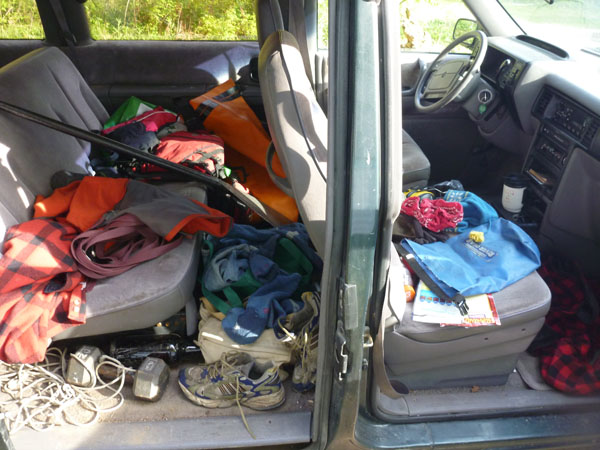
The view after I got home.
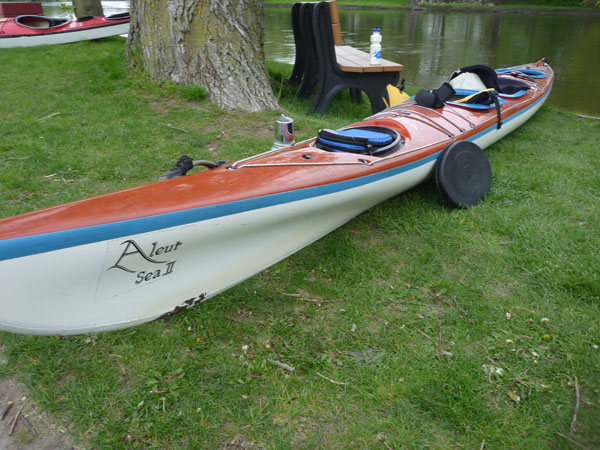
Sweet double sea kayak by Valley so it was probably fast, too. I kinda thought I saw two of these.
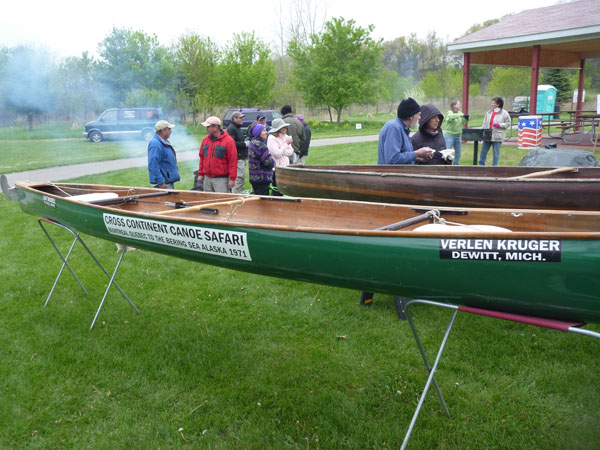
Another view of an amazing canoe.
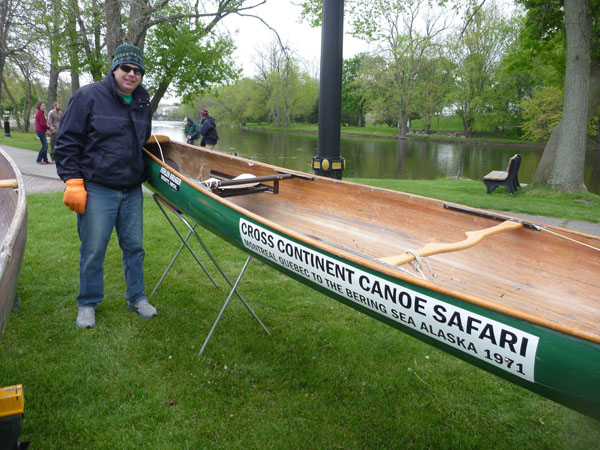
Tim is a fan of the 21-foot canoe that Verlen and Clint used to paddle *7000* miles in ONE summer across Canada. It’s actually a quite narrow, shallow-draft race-type boat — amazing they hauled 200 lbs of gear in it.
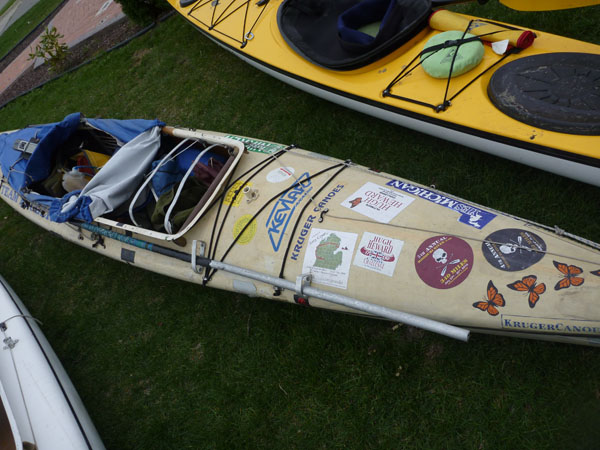
Another view.
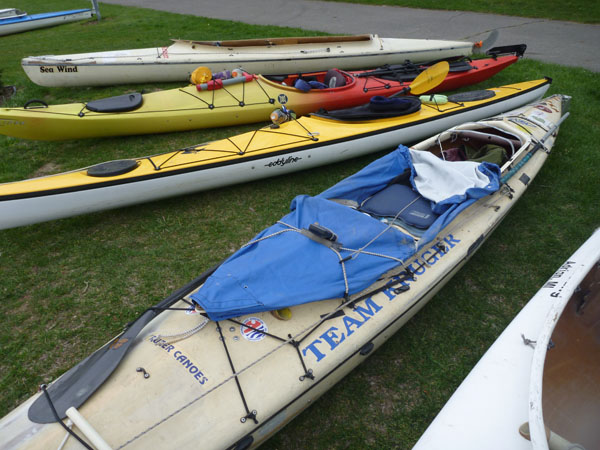
A neat Verlen adventure boat.
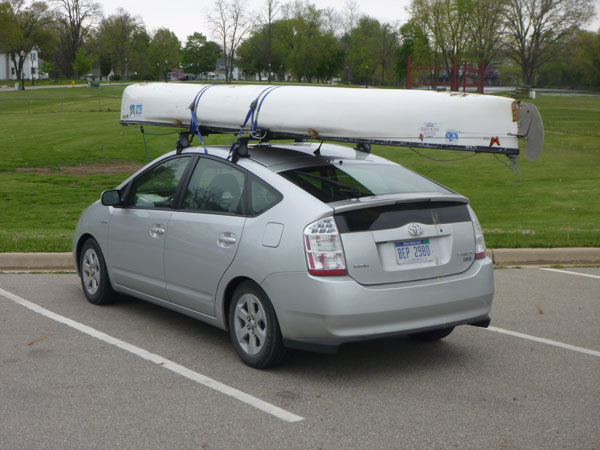
There were TWO Prius’s with Verlen boats on them. This boat seemed kinda stocky compared to the Sea Wind. I didn’t know Verlen designed such different C1’s, but I guess he did. It was a nice car/boat pairing.
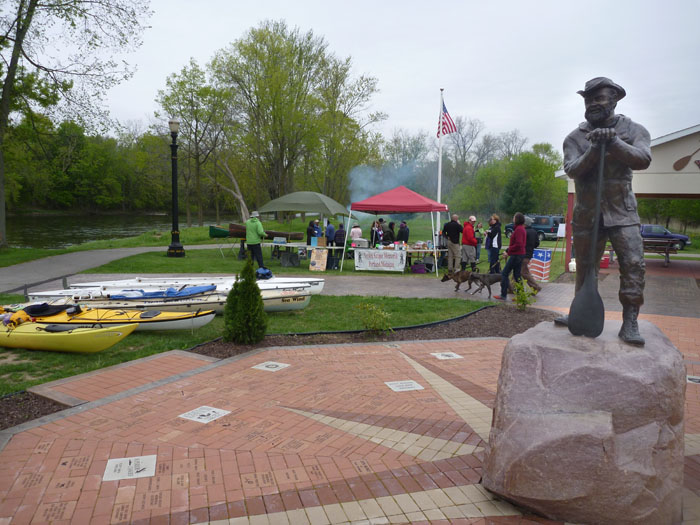
We made it! …The picnic and bonfire at Verlen’s Memorial pavilion at the finish.
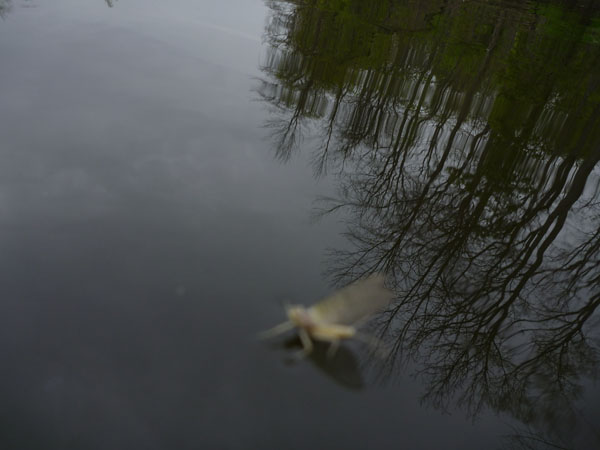
Never did get a good pic of any of the millions of little insect sailboats that accompanied us. But I guess the reflected treeline is sharp.
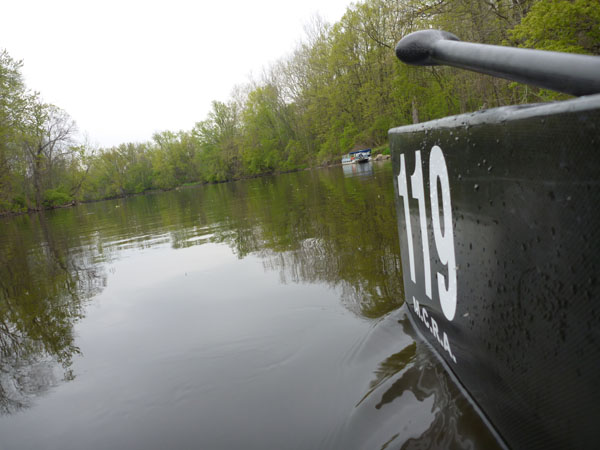
My only pic while under way, an accidental snap while trying to shoot a mayfly.
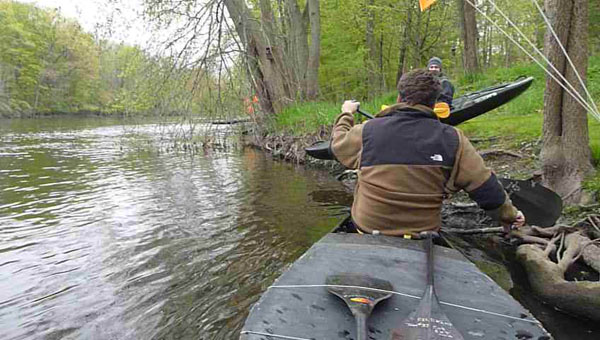
Guy doing seal launch in front of us. Smooth move…
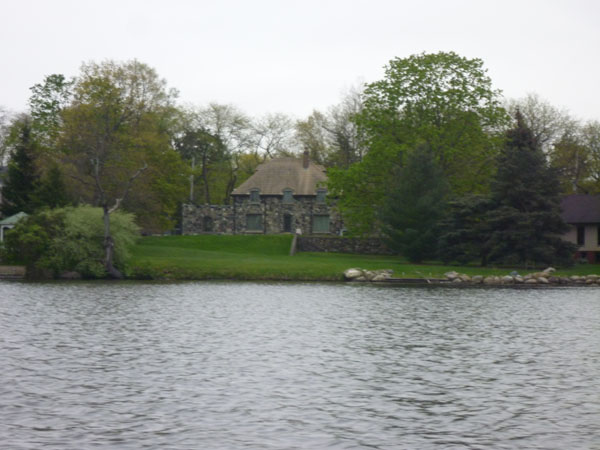
Stone house. I liked the old cottages best but didn’t get any good pics of them.
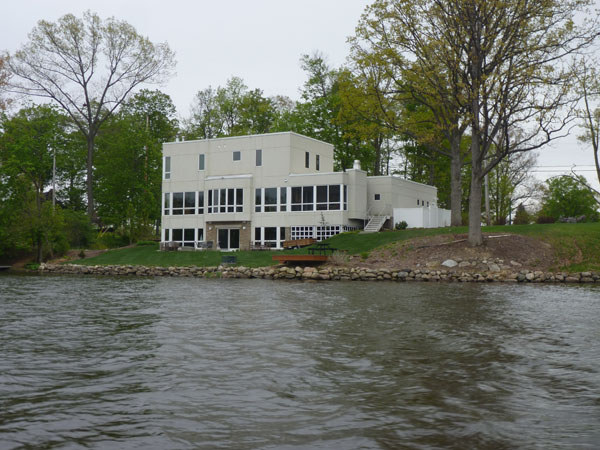
Here’s a neat modern house that I like seeing near Moore’s River Drive down by the MSU Rowing boathouses.
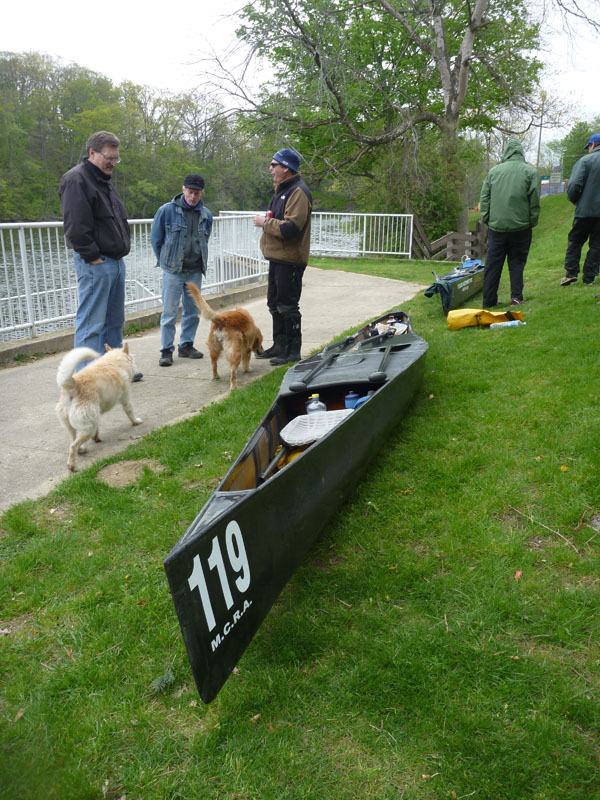
Tim talking to some folks at our lunch stop, with friendly pooches.
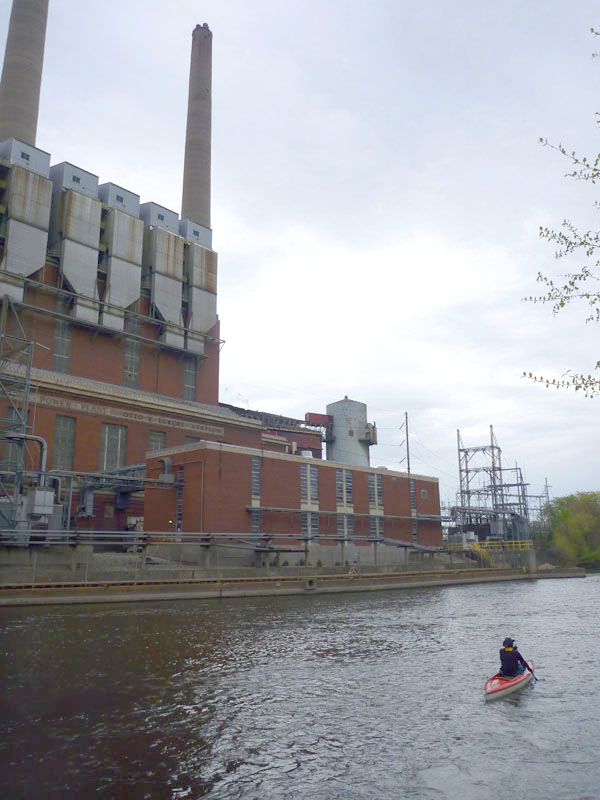
A guy in a Verlen boat taking off from the Power Station below the dam.
